Despite civil unrest, almost half a million Yemenis treated for onchocerciasis
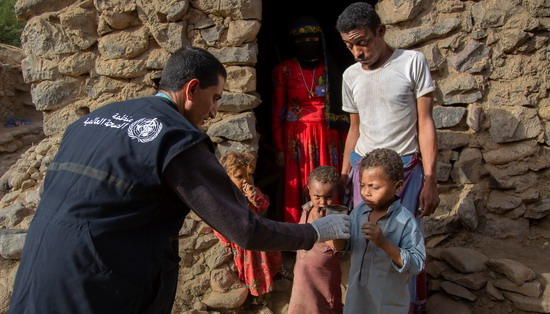 12 February 2019 | Geneva | Cairo | Sanaʽa – Defying logistical challenges and despite ongoing civil unrest and instability, health-care workers in Yemen have been able to distribute medicines through large-scale treatment of people at risk of onchocerciasis in 33 districts of the country’s 8 governorates [1].
12 February 2019 | Geneva | Cairo | Sanaʽa – Defying logistical challenges and despite ongoing civil unrest and instability, health-care workers in Yemen have been able to distribute medicines through large-scale treatment of people at risk of onchocerciasis in 33 districts of the country’s 8 governorates [1].
The 3-day campaign on 28–31 January 2019 was led by Yemen’s Ministry of Health, the World Health Organization’s country office, with support of the Expanded Special Project for Neglected Tropical Disease (ESPEN) and the World Bank through the Emergency Health and Nutrition Project (EHNP).
“We mobilized 970 teams led by 225 team leaders and more than 1935 health workers to assist in the distribution of ivermectin tablets,” said the National Director of Neglected Tropical Diseases Programme, Yemen. “Preparatory works started in December last year and training workshops were decisive in achieving maximum compliance during the campaign.”
Out of a total of 528 420 people targeted in all 8 governorates, 474 027 people were reached and treated, representing 90% coverage.
A total of 1 177 524 ivermectin tablets from the Mectizan Donation Programme were used during this latest campaign.
Onchocerciasis in Yemen
Unlike Africa, Yemen there are no records of eye complications or blindness due to onchocerciasis.
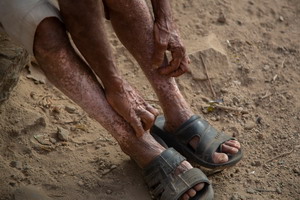 The disease mainly manifests in a localized form, mainly in lower legs in the form of ‘onchodermatisis’ also known as ‘reactive onchodermatitis’. Intense itching and skin irritation associated with severe manifestations leads to skin abrasion and other dermal infections.
The disease mainly manifests in a localized form, mainly in lower legs in the form of ‘onchodermatisis’ also known as ‘reactive onchodermatitis’. Intense itching and skin irritation associated with severe manifestations leads to skin abrasion and other dermal infections.
The disease (locally known as ‘Sowda’ or ‘Sowdah’ referring to black pigementation) is endemic in 33 districts of the 8 governorates posing a risk to a total population of 3 million people.
Prevalence of onchocerciasis in Yemen is confined to the valleys running west of the Red Sea with over 60% clinical cases in the worst affected valleys. These areas abound with rapidly flowing water during the country's rainy seasons (usually between April and September) prompting fly breeding to take place. In Yemen, the vector for O.Volvulus is the blackfly, S. rasyani.
Prospects for elimination
Although Yemen started its onchocerciasis and lymphatic filariasis control programme as part of the National Leprosy Programme in 1992, targeting all people at risk of carrying microfilariae and susceptible to maintaining transmission even at a low level. The disease is under control and the national target is to achieve elimination as a public health issue as outlined in WHO’s Regional Office for the Eastern Mediterranean’s roadmap.
It is thanks to the technical support provided by the Regional Office and the dedicated work of local health workers and volunteers that treatment campaigns targeting everyone at risk are being sustained.
[1] Sana’a, Hajja, Ibb, Al-Mahweet, Dhamar, Raimah, Al-Hudaydah and Taiz
Cancer patients face ‘death sentence’ in Yemen
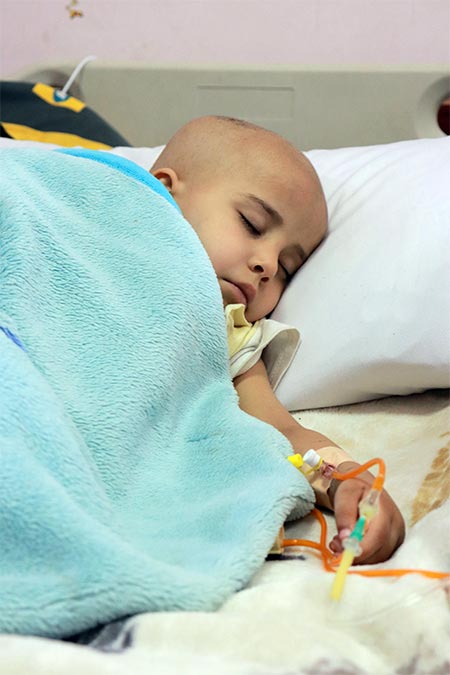 Layan was finally able to sleep after crying from the pain of the cannula that has been attached in her hand for days4 February 2019 – “Mum, it hurts very much.” With tears in her eyes, 4-year-old Layan describes to her mother how she feels about the cannula that has been in her hand for days.
Layan was finally able to sleep after crying from the pain of the cannula that has been attached in her hand for days4 February 2019 – “Mum, it hurts very much.” With tears in her eyes, 4-year-old Layan describes to her mother how she feels about the cannula that has been in her hand for days.
Layan was diagnosed with non-Hodgkin lymphoma – a type of cancer that affects the lymphatic system – in March 2018. “When we admitted Layan to hospital, there were no empty beds and we had to wait for days until she was finally able to receive treatment. My heart aches and no words can describe how I feel seeing my little daughter endure the pain of illness,” says Abeer, Layan’s mother.
Mohammed Ahmed, 3-and-a-half years old, suffers from kidney cancer. With a beautiful, heart-capturing smile, he tells the doctor that he wants to go home. So far, Mohammed has had 6 chemotherapy sessions over 8 months and is scheduled for 2 more in the coming months. Mohammed’s family is trying to move from Ibb to Sana’a to avoid the high cost of transportation.
Providing urgent health care to millions: WHO and the Italian Agency for Development Cooperation work together to reach the most vulnerable
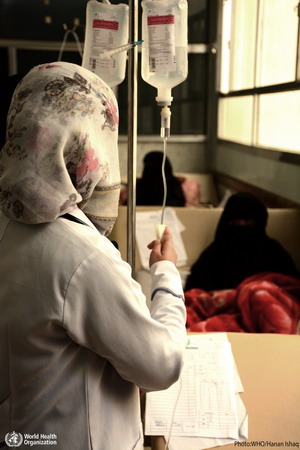 24 January 2019, Sana’a, Yemen — With a generous donation of 2 million euros from the Italian Agency for Development Cooperation, the World Health Organization (WHO) is scaling up efforts to meet health needs in Yemen through the health service delivery mechanism known as the Minimum Service Package. This is the first time since the start of the crisis in Yemen that WHO has partnered with the Agency.
24 January 2019, Sana’a, Yemen — With a generous donation of 2 million euros from the Italian Agency for Development Cooperation, the World Health Organization (WHO) is scaling up efforts to meet health needs in Yemen through the health service delivery mechanism known as the Minimum Service Package. This is the first time since the start of the crisis in Yemen that WHO has partnered with the Agency.
This critical support will allow WHO to reach more than 600 000 of the most vulnerable people in need of essential health services in hard-to-reach areas of Al Hudaydah, Amanat Al-Asimah and Hajjah governorates. The objective is to provide health services through the Minimum Service Package while strengthening the health system with support from health partners across the entire country, ensuring the “right to health” for all Yemenis.
Cholera and malnutrition in Yemen threatens millions
 27 December 2018 ─ Al Sabeen Hospital in Sana’a has admitted many cholera patients over the last 2 years, including infants as young as 2 months. Many of them also suffer from acute malnutrition. At the peak of the cholera outbreak more than 150 patients a day were being admitted to Al Sabeen hospital with severe watery diarrhoea. Some 20% of the total were diagnosed with cholera.
27 December 2018 ─ Al Sabeen Hospital in Sana’a has admitted many cholera patients over the last 2 years, including infants as young as 2 months. Many of them also suffer from acute malnutrition. At the peak of the cholera outbreak more than 150 patients a day were being admitted to Al Sabeen hospital with severe watery diarrhoea. Some 20% of the total were diagnosed with cholera.
Two-and-a-half-year-old Ramez and eight-month-old Mohamed are brothers. Small and frail, they have been diagnosed with cholera and are moderately malnourished.
Their family moved from Hajjah to Sana’a after their father lost his job.
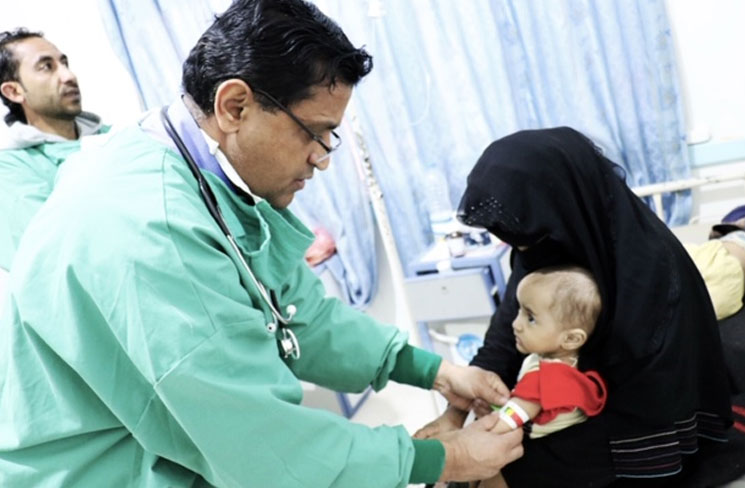 “In Hajjah we used to drink pure water from wells,” says the boys’ mother, “but after moving to Sana’a we had to drink from water trucks.”
“In Hajjah we used to drink pure water from wells,” says the boys’ mother, “but after moving to Sana’a we had to drink from water trucks.”
It is almost 4 years since war erupted in Yemen, with devastating consequences for the country’s infrastructure and health system.
Despite ongoing humanitarian food assistance the latest IPC analysis - covering December 2018 to January 2019 - revealed 15.9 million people (53% of the population) faced food shortages. Of these, 17% of the population - about 5 million people - are classified as IPC Phase 4 (Emergency), and 36% - 10.8 million people - as IPC Phase 3 (Crisis).
Like millions of Yemenis, Ramez and Mohammed’s parents face a constant struggle to access healthcare, pay rent and feed their children.
“I have 3 more children. Their father is looking after them at home,” says the boys’ mother.
Within minutes she receives a phone call from her husband who tells her the children at home are starting to show signs of infection. They agree he should bring them to the hospital straight away.
Abdulmajeed Yahya is 8-months-old and weighs a little over 3 kilograms. He has been severely malnourished for over a month. He was diagnosed with cholera at Al Sabeen Hospital seven days ago, after making the 5 hour journey to Sana’a from Al Haymaharea with his mother and father.
“My husband lost his job after the war started and is now unemployed. We had to borrow money so we could come here from Al Haymaharea,” says Abdulmajeed’s mother.
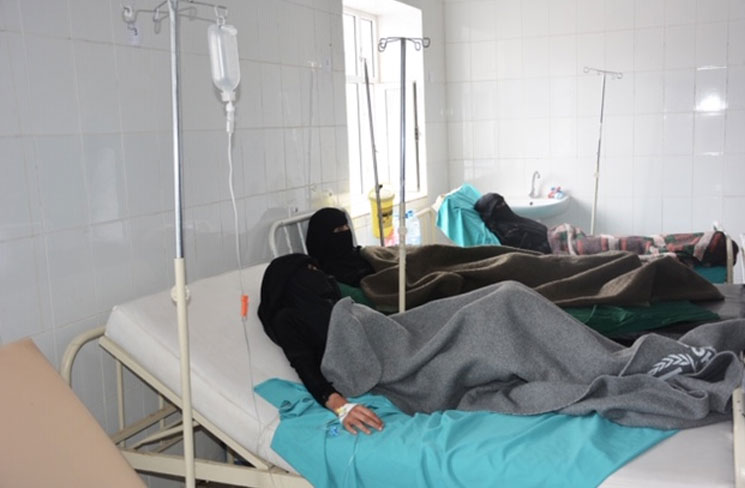 Sana’a’s 22 May Hospital treats many internally displaced families. It, too, sees large numbers of patients with symptoms of cholera and children suffering medical complications as a result of malnutrition.
Sana’a’s 22 May Hospital treats many internally displaced families. It, too, sees large numbers of patients with symptoms of cholera and children suffering medical complications as a result of malnutrition.
“We see two new patients suffering from cholera and malnutrition a day, many of them from families who own close to nothing. The hospital cannot accommodate in-patients so cases suffering from severe acute malnutrition with medical complications have to be referred to other hospitals,” says Suha Abdeen, a nurse on the hospital’s nutrition ward.
Jameel Moanis is 12-months-old and weighs just 3 kilograms. He was brought to 22 May Hospital a few days ago from Al Hudaydah and had to be referred to another hospital for more specialized treatment.
To help severely malnourished children suffering from medical complications WHO supports 269 health facilities in Yemen and has established 51 therapeutic feeding centres in 17 governorates. WHO has also established 72 diarrhoeal treatment centres and 25 oral rehydration centres for the treatment of cholera and other diarrhoeal diseases.
WHO works closely with the Ministry of Health and WASH cluster partners to contain cholera outbreaks, offering technical and logistical support to strengthen disease surveillance, assist diarrhoeal treatment and oral rehydration centres, train health workers on case management, deploy rapid response teams and improve sanitation and access to safe water.
There have been 280 198 suspected cases of cholera since the beginning of 2018, and 372 associated deaths. Children under 5 account fort 32% of the total suspected cases. Cholera has been reported in 22 out of Yemen’s 23 governorates, and 306 out of the country’s 333 districts.


